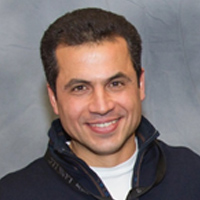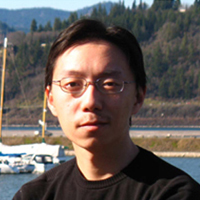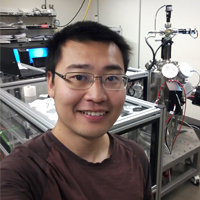Toy Model Magnetism
February 22, 2022
UT’s physicists have helped discover a novel type of magnet, the result of collaborative brainstorming and creating "toy model" materials to solve complex problems. Nature Communications published their findings on the realization of an antiferromagnetic excitonic insulator, a long-predicted phenomenon that takes advantage of electrons’ spins and how they behave in a quantum system. A deeper understanding of how electrons work in these materials can set the framework for devices that function at smaller scales.
The paper’s lead author is Mark Dean, a physicist at Brookhaven National Laboratory and an adjunct associate professor of physics at UT. The university connection arose from his work with Associate Professor Jian Liu, one of multiple UT physicists on this experiment. Dean explained that broadly speaking they’ve found "a novel type of magnet," which is fascinating both in terms of basic fundamental science and possible technological applications.
While metals are conductors and allow electric current to move freely, insulators (e.g., plastic or glass) prevent it from doing so. Semiconductors (also known as integrated circuits or microchips) fall in between. The latter are enormously useful because their electrical resistance can be modified for applications like computing and smartphones. The research in Nature Communications takes the scientific principles of metals and insulators into more sophisticated territory, looking at how a material can change states based on its electrons’ properties.
What, exactly, is an antiferromagnetic excitonic insulator? It starts with electrons, whose spins produce tiny magnetic fields. In antiferromagetism, electrons arranged side by side have spins that alternate—up-down-up-down—cancelling out one another and quenching magnetism. This makes the host material less vulnerable to an outside magnetic field, which could, for example, erase data stored in a computer’s memory.
In an insulator, electrons are kept in tight quarters and can’t move around easily; hence the lack of electric current. Yet in solid materials there are different energy levels, called bands, and if electrons can find the energy to make the hop from the lowest, crowded energy band to another level, they’ll do it. When they make that leap, they leave behind a hole. If an electron and hole bind together, they form an exciton, a neutral quasiparticle that can carry energy.
For this work, the research team synthesized single crystals of strontium iridium oxide (a nominal insulator at high temperature) and then slowly cooled the sample. They used resonant inelastic x-ray scattering (RIXS) to measure magnetic interactions. As the temperature dropped, the gap between the energy levels began to shrink. Electrons hopped across the gap and quickly bound themselves to the resulting holes, actually creating a surplus of energy. At the same time, they triggered alternating electron spins, setting up antiferromagnetism. Once all the electrons had changed places, the material’s new configuration was an antiferromagnetic excitonic insulator.

Cristian Batista

Jian Liu

Junyi Yang
For Liu, the results point to a new starting line in understanding electronic properties in quantum systems, where materials may comprise just a few layers of atoms. Confined dimensions affect how electrons can move and what properties show up because of those restrictions. In this experiment, the electron-hole pairs are bound perpendicularly as they move laterally, presenting the perfect conditions for an exciton to emerge. It also means metals aren’t the only option when it comes to magnetism.
Liu said the conventional view holds that magnetism often arises when a material is driven from a metallic state to an insulating state (known as a Mott insulator).
"We show this doesn't have to start from a metal and lots of interesting physics is yet to be explored when starting from an insulator or semiconductor," he said. "This could lead to a new class of insulator/semiconductor." It could also tell physicists more about how materials change phases.
"What is interesting is that it's not easy to distinguish which scenario a system is in if the material is already a magnetic insulator," Liu said. "This is like we can't really distinguish ice and dry ice until they become water and CO2 gas. That is why going to the other side of the quantum phase transition is important."
The Nature Communications research was actually inspired by theory calculations Lincoln Chair Professor Cristian Batista did for an earlier study on an antiferromagnetic Mott insulator. He and Liu wanted to see if they could extend the model to a system with higher dimensionality.
Hidemaro Suwa, a former UT postdoc now with the University of Tokyo, and current postdoc Shang-Shun Zhang worked with Batista on calculations and developing a model of what they expected the new experiment to show. Physics Graduate Student Junyi Yang travelled to the Advanced Photon Source at Argonne National Lab to run the experiment with members of Dean’s group: Daniel Mazzone and Yao Shen.
"The results agree very well with the theoretical predictions," Liu said. "This work is a good example of the magic of quantum mechanics in low-dimensional solids as well as the productive interplay between theory and experiment."
The combined strengths of experimentalists and theorists, as well as universities and national laboratories, make studying quantum systems more accessible.
"The way we came with the idea of this work shows the importance of experimentally realizing toy model materials and developing computational tools that can handle complex problems beyond perturbative approaches," Liu said. "This combination, plus good collaborative brainstorming, is the recipe for successful adventures."
Some content adapted from Brookhaven National Laboratory’s official press release. Many thanks to their Media and Communications Office.